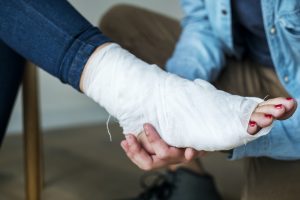Pain in the lower legs can make it hard to move throughout the day. Learn about four causes and treatments for ankle and calf pain.
Some people use their legs for running and fitness while others simply use them for moving around the house. Regardless of how you use them, lower leg pain can hinder your daily activities and make it a hassle to do simple tasks.
A visit to the doctor can help determine if the pain is serious enough for medical intervention. However, there are also things you can do at home to help ease the pain.
The following are 4 causes of lower leg, ankle and calf pain, as well as how to treat them.
1. Shin Splints
Experiencing shin splints is no picnic, as the pain often goes right up to the front of your calf. Inflammation of the muscles and flesh along the edge of the shin bone is what causes the condition.
Shin splints can make it painful to walk, run, jump, or doing repetitious activity on hard surfaces. People with flat feet or those with feet that turn outward are more likely to get this condition.
Treatment: Put some ice on your legs and let them rest. Over-the-counter medication like ibuprofen, aspirin, and naproxen can also help.
Lastly, avoid doing anything that makes your legs hurt and wear comfortable, supportive shoes.
2. Tendinitis
If you experience pain in your lower calf, around the back of you heel, it could be a sign of an inflamed Achilles tendon. The injury can make the tendon stretch, swell, or tear and happens from something as basic as climbing the stairs to simply overworking the calf muscle.
Unfortunately, this type of injury can last for a while, especially if unattended.
Treatment: Take anti-inflammatories and apply ice around the area for relief. Once the pain starts subsiding, stretch and strengthen the affected leg.
However, in cases where the pain is severe, you may have a torn tendon and will need to visit the doctor. In such cases, the doctor may need to inject the inflamed area and perform surgery to repair the damage.
 3. Sprains and Breaks
3. Sprains and Breaks
Mild sprains can result from twisting your ankle, while more intense pain can be a sign of a severe sprain or a fracture.
Treatment: For mild sprain, apply the RICE treatment: Rest, Ice, Compression, and Elevation.
For severe sprains and fractures, apply some ice and visit your doctor immediately. Broken legs will usually need a cast, brace, and maybe even physical therapy.
4. Muscle Cramp
A more common affliction of the legs are muscle cramps, which can happen at virtually any time of the day. Also known as a charley horse, muscle cramps happen suddenly and cause an intense pain in your lower legs.
The cause of these cramps is usually dehydrated and tired muscles.
Treatment: If you experience leg cramps regularly, try drinking more water and stay hydrated. Furthermore, you can massage and gently stretch the affected area to help relieve some of the pain.
If you’re planning to exercise, make sure you properly stretch your legs to avoid any cramps.
What else can I do?
Fitness-focused people can often experience muscle cramps by not stretching or getting the adequate nutrition to their muscles. Poor circulation often leads to poor nutrient delivery, as well as other conditions such as blood clots and varicose veins.
Conditions such as peripheral artery disease can block blood flow to your lower legs and not uncommon in people with hypertension, diabetes, and high cholesterol.
If the reason for the pain in your lower legs is poor circulation, then supplements can help. For example, L-arginine Plus helps support circulation by increasing the nitric oxide levels in the body.
Nitric oxide is a molecule that dilates blood vessels, helping to improve blood flow in a safe and natural way. If you’re looking for a way to healthily support your circulation, cholesterol and overall health, then try L-arginine Plus.

